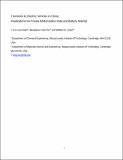Transition to electric vehicles in China: Implications for private motorization rate and battery market
Author(s)
Hsieh, I-Yun Lisa; Pan, Menghsuan Sam; Green Jr, William H
DownloadHsieh_China Vehicle Market_Energy Policy (accepted).pdf (987.0Kb)
Publisher with Creative Commons License
Publisher with Creative Commons License
Creative Commons Attribution
Terms of use
Metadata
Show full item recordAbstract
China has recently enacted the dual-credit mandate to replace the existing subsidies as a continued effort to electrify its ground transportation sector. This study quantifies the impacts of such policy transition on private motorization rate and battery market. Throughout the next decade, affordability remains the determinant for vehicle purchases; forcing broader adoption of pricier battery-powered cars without subsidies will inevitably diminish the market growth. Under the mandate, China's electric vehicle sales will continue to grow through 2030 despite the temporary car market contraction. Cumulative private electric vehicle sales are projected to reach 66 million by 2030 (with 37% sales market share); this will drive the battery demand from China's private car sector to expand rapidly and accumulate ~420 GWh (2 million tonnes) of spent lithium-ion batteries. This significant increase in battery demand will exacerbate pressure on the global supply for lithium and cobalt. The cobalt demand from China's private vehicle sector in 2030 alone would be almost half of the total global cobalt production in 2017; up to 16% of this 2030 demand could be satisfied by battery recycling. A recycling-based battery supply chain is needed to alleviate the concerns of supply shortages and to achieve a circular economy.
Date issued
2020-09Department
Massachusetts Institute of Technology. Department of Chemical Engineering; Massachusetts Institute of Technology. Department of Materials Science and EngineeringJournal
Energy Policy
Publisher
Elsevier BV
Citation
Hsieh, I-Yun Lisa et al. "Transition to electric vehicles in China: Implications for private motorization rate and battery market." Forthcoming in Energy Policy 144 (September 2020): 111654 © 2020 Elsevier Ltd
Version: Author's final manuscript
ISSN
0301-4215